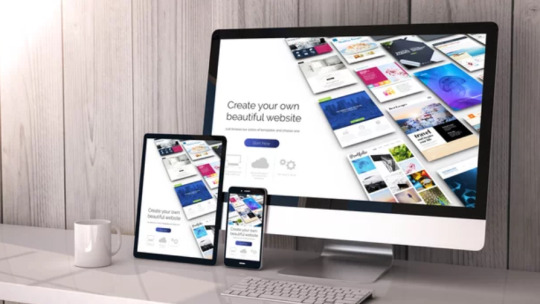#cheap web design
Explore tagged Tumblr posts
Text
#web design#website#web design india#web designers#website design#website design india#web development#cheap web design#website design company#website redesign#website development
2 notes
·
View notes
Text
Affordable E-Commerce Web Design: What Can You Expect?

If you’re planning an online store on a tight budget, you’ve probably wondered: Can a cheap web design setup really handle the demands of an e-commerce business?
It’s a fair concern. “Cheap” often suggests limited functionality or compromises in quality. But the answer depends on your budget, your store’s requirements, and how much you’re willing to work within constraints.
Defining “Cheap” Web Design
Cheap web design typically refers to solutions costing a few hundred dollars—or less if you’re using a DIY platform or a friend’s help.
This usually means pre-made templates, basic features, and little custom work. A cheap website designer often relies on tools like Squarespace, Shopify, or WordPress to keep things affordable and fast.
That’s not necessarily a problem. These platforms are built to support e-commerce, even for beginners. But they have limitations. If you’re fine with those, it can be a solid way to start.
Why E-Commerce Isn’t So Simple
Running an online store seems easy: add products, set prices, and enable checkouts. But there’s more to it than that.
Your site needs to support browsing, product options (like colors or sizes), secure payments, order confirmations, and shipping updates. You might also want to offer discounts, track inventory, or allow customer accounts. Each feature adds complexity, and getting them to work smoothly takes effort.
Cheap web design can hit a wall here. The tools are capable, but the setup and testing needed to make everything run seamlessly often go beyond what budget services offer.
Common Issues with Budget Designs
Low-cost designs often face a few hurdles. Site speed is a frequent problem—cheap sites can slow down as you add products or plugins, driving customers away.
Mobile compatibility is another challenge. Many affordable sites aren’t optimized for phones, leading to awkward navigation or checkout issues. Since mobile shopping is so common, this can hurt your sales.
Security is also a risk. Some cheap website designers cut corners on things like SSL certificates or site maintenance, which can expose your store to vulnerabilities.
These problems can be addressed, but fixing them often requires work that budget packages don’t include.
When Does It Work?
Cheap web design can be enough for small, simple stores. If you’re selling a few items, don’t need complex features, and are willing to do some work yourself, it’s often sufficient.
It’s also ideal for testing a concept. If you’re launching a new product or side project, a budget-friendly site lets you get started without a big financial commitment. Just be realistic about what you’re getting.
But if your store is central to your business or you plan to grow fast, a cheap solution may not suffice. Fixing a basic site later can cost more than building it properly from the start.
What to Check Before You Commit
Before hiring a cheap website designer or choosing a platform, ask the tough questions. Will the site work well on mobile? Can it handle secure payments? Is it easy to manage products? What happens if something goes wrong?
Unclear answers are a red flag. A good designer, even on a budget, should be upfront about what’s included and what’s not.
Also, consider what happens after launch. Many affordable services stop once the site is live. If you’re not ready to handle updates or troubleshoot issues yourself, that low price could lead to stress later.
The Takeaway
Cheap web design can support e-commerce, but it’s not without compromises. How well it works depends on your store’s needs, your willingness to handle some tasks, and how much risk you’re okay with.
For simple setups, it’s often a fine starting point. But for a professional, reliable, and scalable store, spending a bit more upfront for a solid foundation is usually the better move. Not flashy—just secure, functional, and ready to grow.
Start small if you must, but don’t lose sight of the bigger picture. A glitchy or slow site can cost you more than a slightly higher budget upfront.
0 notes
Text
Cheapest Web Design UK | Cheap Website Creator
0 notes
Text
Free Initial Consultation: Offering a free initial consultation to discuss project requirements.
Contact us now at 9871115060
visit www.warals.com
0 notes
Text

Low-Cost Web Design Wizards: Making Your Online Dreams Affordable! starting price at only rupees 1999/- only
#low cost web design#cheap web design#affordable web design services#affordable web design services in mumbai#low cost website design company in mumbai
0 notes
Text
How to Create Effective Landing Pages Without Breaking the Bank
Creating effective landing pages is an important part of any marketing strategy. A landing page is a standalone web page that is designed to convert visitors into customers. It should be simple, straightforward, and easy to navigate. Avoid clutter and keep the design clean and minimalistic. This will help visitors focus on the main message and call-to-action (CTA) of the page.
One of the biggest challenges when it comes to creating effective landing pages is finding a web designer who can deliver high-quality designs without breaking the bank. This is where cheap web design and cheap web designers come in. These terms refer to the use of pre-designed templates or website builders that can be easily customized to fit your brand and message. These options are often much more affordable than hiring a professional web designer, but they can still deliver high-quality results.
When it comes to creating an effective landing page, there are a few key elements to focus on. First, make sure your headline is clear and prominent. This should be the first thing visitors see when they land on your page. Use a large font size and bold text to make it stand out. Next, include a compelling image or video that supports your headline and message. This could be a product image, a customer testimonial, or a short explainer video.
Another important element of an effective landing page is the use of a clear and concise CTA. This should be a button or link that encourages visitors to take action, such as "Sign up now" or "Learn more." Use contrasting colors and font sizes to make the CTA stand out from the rest of the page.
In addition to these design elements, it's important to optimize your landing page for search engines. This means including relevant keywords in your headline, subheadings, and meta description. This will help your page show up in search results when people search for those keywords.
Overall, creating effective landing pages without breaking the bank is possible with a little creativity and resourcefulness. By using pre-designed templates or website builders, you can create high-quality landing pages that drive sales and grow your business. Don't be afraid to experiment and try new things – sometimes the simplest designs are the most effective.
In conclusion, cheap web design and cheap web designers are not just affordable options, they can also deliver high-quality results. By focusing on the key elements of an effective landing page, such as a clear headline, compelling image or video, and clear CTA, you can create a page that drives sales and grows your business. With a little creativity and resourcefulness, you can create a landing page that looks great and performs even better, all without breaking the bank.
0 notes
Text
Costly Errors to Steer Clear of When Pursuing Cheap Web Design
The expense of professional website design and development can be daunting, especially for new startups and small businesses on limited budgets. This leads many owners to seek DIY solutions or extremely cheap web design in hopes of saving money.
However, chasing the lowest possible website cost often backfires through damaging shortcuts, hidden fees and fatal flaws that require expensive reworking. When evaluating bargain-priced web design options, beware of these common budget-busting mistakes:
Opting for Do-It-Yourself Site Builders
User-friendly DIY website builders like Wix, Weebly, and Squarespace enable anyone to create a basic website with no coding skills required. But while convenient, their cookie-cutter templates severely limit customization options compared to hiring a professional cheap web designer. You sacrifice uniqueness and capabilities.
Skimping on Responsiveness
With mobile usage now dominant, a website must adapt seamlessly to any screen size. However responsive design is often carved out as an add-on service to drive up fees. Lack of mobile optimization cripples the user experience and SEO. Don’t accept a non-responsive site to save money upfront. The long-term costs will be much higher.
No Attention to Site Speed
Slow page load times hurt conversions and search rankings. However many bargain web designers ignore speed optimization entirely. Always evaluate actual metrics like time-to-interactive and page speed. Anything above 3 seconds is unacceptable. Speed optimization should be standard, not a premium add-on.
Minimal Revisions Allowed
Cheap web designers often impose strict limits on design revisions after initial site delivery, sometimes just 1-2 rounds. This prevents fixing flaws or aligning the site with your evolving brand. Seek unlimited revisions for at least 2-3 months, even if it costs more.
Cutting Corners on Security
SSL certification and other security measures are must-haves, not optional add-ons. But some cheap web designers make security an upcharge. Never compromise the protection of customer data and transactions. Security gaps will cost you much more long-term through breaches.
No Post-Launch Support Plan
Cheap web designers may wash their hands of you after an initial handoff, leaving you stranded when issues arise. Make sure continuous technical support and maintenance are contractually guaranteed for 6-12 months at a minimum. Paying extra here prevents headaches.
Hidden Subscription Fees
Cheap web design deals sometimes lure you in with seemingly cheap monthly subscriptions that end up ballooning over time. Watch for auto-renewals, long lock-in contracts, limitations on site hosting, and sneaky premium feature add-ons. Read the fine print!
Cutting Corners on Design
While professional custom design has a huge branding impact, some cheap web designers rely on cookie-cutter templates and stock imagery. Don’t compromise uniqueness and quality. Review portfolios closely and invest in custom graphics if needed.
No SEO Optimization
Many cheap web design packages exclude crucial SEO best practices like metadata optimization, alt text, compression, sitemaps, and page speed. But SEO is the most valuable traffic driver. Don’t settle for a site that ignores optimization to rank higher.
In summary, the lure of rock-bottom pricing often obscures serious downsides. Avoid the above mistakes and carefully vet cheap web designers to uncover any hidden gotchas before signing a deal. Your goal is maximizing long-term value, not just short-term savings. With diligence, you can find cheap website design that delivers quality without preventable pitfalls.
0 notes
Text
Weba - Top Domain Provider in the Caribbean

Weba is the Fastest Growing Domain Provider in the Caribbean! They offer Domains, Hosting, Cyber Security & Web Design. All the services needed for your new website.
Visit: https://weba.co
#weba#weba.co#www.weba.co#https://weba.co#domains#domain#buy domain#buy domain name#hosting#cheap domain#web design
3 notes
·
View notes
Text
I finally got my artists website up and running + am sharing it and I took a look at a lot of my classmates websites and dear lord they are so bad. Give me $100 I will make you a new one over break.
#normally I charge $800 + $100 per update which for web design? cheap.#but I will literally do this shit for (almost) free dude. your portfolio is impossible to navigate
4 notes
·
View notes
Text
What is Keyword?
(Niketank Mogha)
You came on this article to know What is Keyword. so lets start, If you only take information from the internet, then you would hardly know that What is Keyword? But if you are a blogger or digital marketer and want to make your career in the field of digital marketing, then you must have heard the word Keyword and You need to know about What is Keyword? (Niketank Mogha)
You may have seen many videos, read articles in which keywords have been mentioned. But if you have not yet understood What is Keyword. are, what are the types of keywords and what is keyword research, then after reading this article all your doubts will be cleared.
In this article, I have given you complete information about What is Keyword in very simple words, I am sure that after reading this article till the end, all the doubts related to your keywords are going to be removed, so definitely read this article till the end.
(Niketank Mogha)
So let’s start this wonderful article first of all.
What is Keyword?
To get information from the Internet, the same words that a user uses to find information or to access information are called keywords.
The way of searching information of every internet user is different. Means every user searches for information on the Internet using different types of words. A keyword is formed when the same word is searched thousands of times.
Now you have a clean, simple, short and point to point defination of What is Keyword and you have understood very well that What is Keyword.
Types of Keywords?
Now you know What is Keyword. so now I will tell you types of Keyword. There are many types of keywords. There are some given below:
1)Fresh Keyword:
Fresh Keywords are keywords that are searched a lot for some time, meaning keywords related to trending topics come under the category of fresh keywords. Fresh keywords are not searched for a long time, they are searched for only a few time periods.
2) Ever Green Keyword:
The most frequently searched keywords are Ever Green Keywords. These keyword categories have been searched in the past, are being searched currently, and will continue to be searched. Ever Green Keyword continues to have a high search volume.
For Example: How to make money online, How to start business etc
3) Area Targeting Keyword:
Area Targeting Keyword are such keywords in which any one area is targeted.
For example – keywords like Delhi Metro Root, Website Designing Course in Delhi, Data Entry Jobs in Mumbai, Jobs in Delhi, SSC course in Mumbai, Digital Marketing course in Delhi etc. are called Aria Targeting Keyword.
If you do your business in any one area or write about any one area, then Area Targeting Keyword can be very beneficial for you.
4) Customer Targeting Keyword:
Client Targeting Such keywords include those that directly target a certain buyer. A few examples are the Best Laptop Bag for Men, Best Shoes for Men, Best Cricket Bat for U-16 Boy, Sleepers for Women, Sunglasses for Women and Best Cricket Kit Bag for Men.
5) Product Targeting Keyword
Product Targeting Keyword are keywords that target a particular product. Like – keywords like Boat Watch For Man, Micromax Smartphone, Apple Phones, Samsung Tablets etc.
6) LSI Keyword (Latent Semantic Indexing)
LSI Keyword are those keywords which are related to our Main Keyword. The main reason for using LSI keywords in our articles is that our articles rank on these keywords as well, and we get good traffic. We also call these keywords as secondary keywords. LSI keywords are very important in the ranking of articles. That’s why these keywords should always be used in the article.
For example you are writing an article on “What is Computer”. So this will be your focus keywords. You can add more details in your article like Computer History, Types of Computer, Old Generation Computer vs Today’s Generation computer so these words are related to your main keyword. You can use these keywords in your article to gain more traffic as a related keyowords on your post or website. (What is Digital Marketing?)
What is Keyword Research?
After reading the article till here, you must have understood that What is Keyword, now know what is Keyword Research. Because a blogger should have knowledge about keyword research
Keyword research is very important for a blogger. When you write your article on any topic, first you have to do keyword research in a good way. You have to see how many people search the keyword you have selected, how much competition is there and how much CPC you are getting on that keyword.
When you write articles by researching keywords well, then only traffic comes to your blog, and when there is traffic on your blog, then only you can earn money from blogging.
If you work on keywords that people do not search, then no matter how hard you work on the blog, traffic will not come to your blog. Understand that writing articles without keyword research is like shooting in the dark.
You will find many free keyword research tools on the internet, with the help of which you can do keyword research for your blog. Like – Ubersuggest, Wordtracker etc.
Types of keywords based on keyword research
Whenever we do keyword research, we find 3 types of keywords –
1 – Short Tale Keywords
Such keywords in which 1 to 3 words are used are called Short Tale Keyword. Search volume is very high in short tail keywords and competition is also very high in these keywords.
If you are new in the field of blogging then you should not work on short tail keywords. Because working on short tail keywords will take a lot of time for your website to rank.
Example – Mobile Phone, Samsung Phone, Samsung Galaxy, Samsung Smart Phone, Biryani Recipe All such keywords are called Short Tale Keywords.
2 – Mid Tale Keyword (Niketank Mogha)
Mid Tale Keywords are the keywords that use three to five words. Both Search Volume and Competition are lower for these keywords than for Short Tale Keywords.
Examples are the Top 5 Best Samsung Phones, Smart Phones Under 5000, and Biryani Kaise Banate hai. Mid Tale Keyword is the name given to this kind of keyword.
3 – Long Tale Keyword
Long-tail keywords are those that contain more than five words. Long Tale Keyword has a lower search volume, but its benefit is that it has very little competition. Your post will rank higher if you focus on long-tail keywords. New bloggers might benefit from using long-tail keywords.
Examples are the Samsung Galaxy Note III Price in India and the Best Smart Phone Under 5000 in India. All of these are long-tailed keywords.
How to do Keyword Research.
Steps to do Keyword Research. (Niketank Mogha)
Step 1: First, you need to define your target audience
Prior to beginning your keyword research, it’s critical to establish your objectives and pinpoint your target market. Establish the goal of your website or content and be aware of your target audience. To create a complete keyword strategy that appeals to your audience, take into account their demographics, interests, and pain concerns.
Step 2: Brainstorm Seed Keywords (Niketank Mogha)
Create a list of the seed keywords associated with your company, sector, or subject. These are the key words that best characterise your offerings in terms of goods, services, or content. Consider the terms or phrases that members of your audience may use to obtain information about your services if you put yourself in their position. Find out what’s hot right now by using resources like Google Trends, industry forums, and social media.
Step 3: Expand Your Keyword List (Niketank Mogha)
When you have your seed keywords, you may now generate related keywords to grow your list. To help you with this procedure, a number of tools are available. Popular options that offer helpful information on search traffic, competition, and associated keywords include Google’s Keyword Planner, SEMrush, Ahrefs, and Moz Keyword Explorer. To catch a larger range of search queries, aim for a healthy blend of long-tail keywords (particular, longer phrases) and short-tail keywords (broader, shorter phrases).
Step 4: Analyze Keyword Metrics (Niketank Mogha)
As soon as you have a complete list of keywords, it’s critical to examine their metrics to ascertain their potential worth. Search volume and keyword difficulty should be your primary focus. In contrast to keyword difficulty, which measures the amount of competition for a certain phrase, search volume shows how frequently a keyword is searched. Targeting keywords that have a strong return on investment (ROI) in terms of traffic and ranking potential requires striking a balance between high search volume and reasonable keyword difficulty.
Step 5: Evaluate Competitor Strategies
To learn more about the keyword tactics of your niche’s top rivals, analyse their websites and top rankings. Determine the keywords they are aiming for and how they use them in their material. You may improve your own approach and find new keyword chances with the aid of our study. Competitor analysis capabilities are available in tools like SEMrush and Ahrefs, and they give useful information on keyword rankings, backlinks, and content gaps.
Step 6: Refine and Prioritize Your Keyword List
Based on the insights gained from your keyword analysis and competitor research, it’s time to refine and prioritize your keyword list. Weed out irrelevant or low-value keywords and focus on those that align with your goals, have decent search volume, and offer a reasonable chance of ranking. Group keywords into relevant themes or topics to facilitate content planning and organization.
Step 7: Create High-Quality Content
Armed with your refined keyword list, start creating high-quality content that aligns with your keywords and provides value to your audience. Incorporate keywords naturally into your titles, headings, body text, and meta tags. However, ensure that your content remains informative, engaging, and readable for human readers rather than solely focusing on search engines. Remember, quality content that meets the user intent is more likely to rank well and attract organic traffic.
Conclusion: In the Keyword research is an ongoing process, you need for continuous monitoring, analysis, and adaptation. By understanding your audience, search and identify relevant keywords, and creating high-quality content for your audience to get more traffic on your blog or website.
After reading this article, whatever doubts you have about What is Keyword, they must have gone away and you must have understood that Keyword Kya Hota Hai and how important they are to improve the ranking of any website. Hello friends, you must have liked this article written by me. In the end, you are requested to share this article with your friends on social media.
(Niketank Mogha)
#keyword#seo#google ads#digital marketing#website designing#web development#social media marketing#cheap website design#Youtube
2 notes
·
View notes
Text
Costly Traps to Avoid in Your Web Design Journey

Launching your first website? It’s an exciting leap. But it’s easy to underestimate the expenses. Many assume they just need a designer, a domain name, and a few images to get started. Sounds straightforward, right?
Not quite.
Web design projects often hide costs that can sneak up on you. Some are small but stack up fast. Others can blow your budget entirely. And if you’re working with a cheap website designer, these hidden fees can sting even more—low prices often mean compromises somewhere.
Here’s what to look out for to keep your budget intact.
1. Domain and Hosting Might Not Be Included
To get your site online, you need a domain (like yourbusiness.com) and hosting (the server that keeps your site running). Some designers bundle these in. Many don’t.
Domains typically cost $10–20 per year. Hosting ranges from $5 a month for basic plans to $35+ for more reliable options.
First-timers often think these are one-time costs. They’re not—you’ll need to renew them regularly.
2. Templates Can Bring Unexpected Costs
A pre-made website template might seem like a budget saver. But templates can come with hidden expenses.
You might face:
Fees for premium features or plugins.
Licensing costs for commercial use.
Charges to hire a developer to tweak an inflexible template.
By the time you’ve fixed a “cheap” template, you might’ve spent more than a custom design would’ve cost.
3. Stock Images Can Add Up
Some designers use free images from the web. Others expect you to provide your own. If you don’t have quality photos, you’ll likely need to buy stock images.
These typically cost $8–30 per image. A full site might need several, and the bill grows quickly.
Using unlicensed images by mistake? That can lead to legal trouble after your site launches.
4. Extra Revisions Can Get Expensive
Most design packages include a few revisions—say, two or three rounds. Go over that, and you’re paying extra, often by the hour or per tweak.
New site owners often need more changes as they refine their ideas. Those small edits can add up fast.
Ask early: How many revisions are included? What’s the cost for extras?
5. SEO Might Be an Extra Charge
A beautiful website is useless if it’s invisible on Google.
Search engine optimization (SEO) covers meta tags, image alt text, and site structure. Some designers include basic SEO. Others charge extra or skip it entirely.
If you’re hiring a cheap website designer, don’t expect SEO to be part of the deal. A site no one finds isn’t worth much.
6. Mobile Optimization Isn’t Always Standard
You’d think every site works on phones these days. Not always. Some designers treat mobile-friendly design as an add-on.
You might get a site that looks great on a laptop but breaks on a smartphone. Fixing it later costs more.
Always confirm: Is mobile optimization built in from the start?
7. Content Writing Might Be Your Job
Designers handle visuals and layout. But the text? That’s often on you.
Some assume the designer will write the content. Many won’t—or they’ll use placeholder text and wait for your input. Hiring a copywriter can cost $300–$1,200, depending on your site’s size.
That’s a surprise you don’t want halfway through the project.
8. Maintenance Isn’t a One-Time Cost
A website isn’t a “set it and forget it” deal. It needs ongoing care.
Software updates, plugin fixes, and security patches are a must. Some designers offer maintenance plans. Others leave you to handle it or hire someone else.
Ignoring maintenance can lead to broken features or security risks. It’s cheaper to maintain than to rebuild a broken site.
9. Cheap Designers Can Cost More Later
A cheap website designer might seem like a great deal. Sometimes, they deliver. But often, you get what you pay for.
They might skip testing across browsers, use outdated tools, or disappear after payment. If your site fails or needs a rework, you’re paying someone else to fix it. That “bargain” can become your priciest option.
Final Tip: Get Clear Answers Upfront
You don’t need to be a tech guru to avoid surprises. Just ask the right questions before you commit.
Who covers domain and hosting?
How many revisions are included?
Is the site mobile-friendly?
Who writes the content?
Is SEO included?
What’s the plan for maintenance?
It’s your website. Know exactly what you’re paying for.
Bottom Line
A website is a major investment. Hidden costs can derail your plans, but you can avoid them with the right questions. Whether you’re working with a high-end studio or a cheap website designer, stay vigilant. Ask questions. Check the contract.
Paying less upfront doesn’t always mean saving money in the end.
0 notes
Text
Looking for��Cheap web design in London that doesn’t compromise on quality? You’re in the right place. We specialize in creating stunning, fully responsive websites for startups, small businesses, and individuals across #London and the wider #Leicester area – all at prices that won’t break the bank.
1 note
·
View note
Text
Low Cost Website Designing Company in Faridabad – Meta Web Solution
Looking for a reliable yet low cost website designing company in Faridabad? Meta Web Solution offers affordable, responsive, and SEO-friendly websites tailored for startups, small businesses, and enterprises. Our expert team ensures quality design, fast loading speed, and mobile compatibility at competitive pricing.
For more information visit:
#Low cost website designing Faridabad#affordable web design Faridabad#budget website design#cheap website designer Faridabad#dynamic website design#website#web solutions#website design company Faridabad
0 notes
Text
WebsiteWaley is low cost website design company offers affordable web design services in mumbai. Get high-quality, budget-friendly website design solutions. Elevate your online presence with our professional web design services. Affordable rates, stunning designs – choose WebsiteWaley for your website needs. visit the website & get in touch with us
#low cost website design company in mumbai#low cost web design#low cost website design company#cheap web design
0 notes
Text
Affordable Website Design for Small Business Affordable Website Design for Small Business. Professional, mobile-friendly, SEO-ready site at the best price. Start growing your business!
#Affordable Website Design#Small Business Website#Budget Web Design#Cheap Website Design#Small Business Web Development#Cost-Effective Website#Affordable Web Solutions#Small Business Online Presence#Website Design Services#Low-Cost Website Design#Custom Affordable Websites#Small Business Website Design#Affordable Web Designers#Small Business Digital Solutions#Website Design Near Me
1 note
·
View note
Text
too many ppl who know nothing about Filipino folklore n culture r talking shit about my ate. she’s based off of the manananggal, which you can compare to the European vampire, if that helps you understand it better. although, i’m reluctant to mention that becuz some ppl, who choose to be ignorant, currently hold the view that she’s just an Asian-colored vampire mishmash monster. she is not. other than the fact that she manages to exist at all, here are some details i appreciate about her.

first, she has a face that looks like my family’s. that’s my lola’s nose. that’s my mom’s birthmark. shit, those are my uncle’s cheekbones. the headpiece features jasmine, our national flower. the translucent petals are cool.

second, you can display her in two pieces, split by the torso. its not just a “cheap gimmick” you ignorant pos. at nightfall, the manananggal severs itself in two, leaving behind a vulnerable lower half while its upper half hunts for nourishment - blood, raw hearts, livers, fetuses. the red fringe represents her dangling intestines, hanging loose as she flies after ripping her body apart. the string detail is on the skirt for consistency, but also, intestines are long as fuck? why wouldn’t they also hang from the bottom, assuming they also get split in half.

while we’re on the outfit, the top is an extremely traditional (Spanish colonial, ugh) style in both fabric and shape. i have attire that looks exactly like it, minus the monster high red foil pattern. the tiny, “woven” sleeve cuffs are a nice touch. the earrings and bracelets look to be woven palm too, but aren’t as effective in plastic. the bottom half skirt is quite a bit shorter than is traditional, and the heels higher. it’s a monster high doll.

most accurate would be barefoot, tbh. but you guys would riot, and again, its a doll. actually, the shoes reference a lot from Filipino culture. the heel is a coconut tree overlooking a kubo, a one-room stilt hut built with natural materials such as bamboo and palm, and specifically made to be remade as necessary. the sole is “wooden”, also an accessible material of which some shoes were made with. it is attached by braid to what looks to be a straw strap. also not unusual for a shoe.

her fan and wings feature embroidery, and if you look closely at the latter, you will see a thin and delicate flora design in between the spider web pattern. this is extremely reminiscent of calado, a type of traditional hand embroidery akin to lace that is difficult as fuck. a dying art, btw.

i didn’t wake up looking to ride this hard for a plastic woman lmao. but if you’re gonna come for her, it better be because of the fluorescent green in her colorway and not because you don’t know what you’re talking about. honestly, a lot of Filipinos are just happy to be considered and celebrated. “wins” like this mean everything. maybe it’s not good enough for your collection, but now you know more about my culture than you would’ve gone out of your way to. and that’s good enough for me.
17K notes
·
View notes